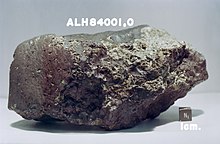ALH84001
| Allan Hills 84001 | |
|---|---|

Meteorite fragment ALH84001
|
|
| Type | Achondrite |
| Clan | Martian meteorite |
| Grouplet | Orthopyroxenite |
| Composition | Low-Ca Orthopyroxene, Chromite, Maskelynite, Fe-rich carbonate |
| Shock stage | B |
| Weathering grade | A/B |
| Country | Antarctica |
| Region | Allan Hills, Far Western Icefield |
| Coordinates | 76°55′13″S 156°46′25″E / 76.92028°S 156.77361°ECoordinates: 76°55′13″S 156°46′25″E / 76.92028°S 156.77361°E |
| Observed fall | No |
| Found date | 1984 |
| TKW | 1930.9 g |
Allan Hills 84001 (commonly abbreviated ALH84001) is a meteorite that was found in Allan Hills, Antarctica on December 27, 1984 by a team of U.S. meteorite hunters from the ANSMET project. Like other members of the group of SNCs (shergottite, nakhlite, chassignite), ALH84001 is thought to be from Mars. However, it does not fit into any of the previously discovered SNC groups. On discovery, its mass was 1.93 kilograms (4.3 lb).
The meteorite is best known for gaining intense media attention in 1996 when a group of scientists claimed to have found evidence for microscopic fossils of Martian bacteria in it, culminating in then U.S. president Bill Clinton giving a speech about the potential discovery. These claims were controversial from the beginning, and the wider scientific community ultimately rejected the hypothesis once all the unusual features in the meteorite had been explained without requiring life to be present. Despite there being no convincing evidence of Martian life, the initial paper and scientific and public attention caused by it are considered to be turning points in the history of the developing science of astrobiology.
This rock is considered to be one of the oldest Martian meteorites, proposed to have crystallized from molten rock 4.091 billion years ago. Based on chemical analyses, it is thought to have originated on Mars from a period when liquid water existed on the now arid planet's surface.
In September 2005, Vicky Hamilton of the University of Hawaii at Manoa presented an analysis of the origin of ALH84001 using data from the Mars Global Surveyor and Mars Odyssey spacecraft orbiting Mars. According to the analysis, Eos Chasma in the Valles Marineris canyon appears to be the source of the meteorite. The analysis was not conclusive, in part because it was limited to areas of Mars not obscured by dust.
...
Wikipedia
